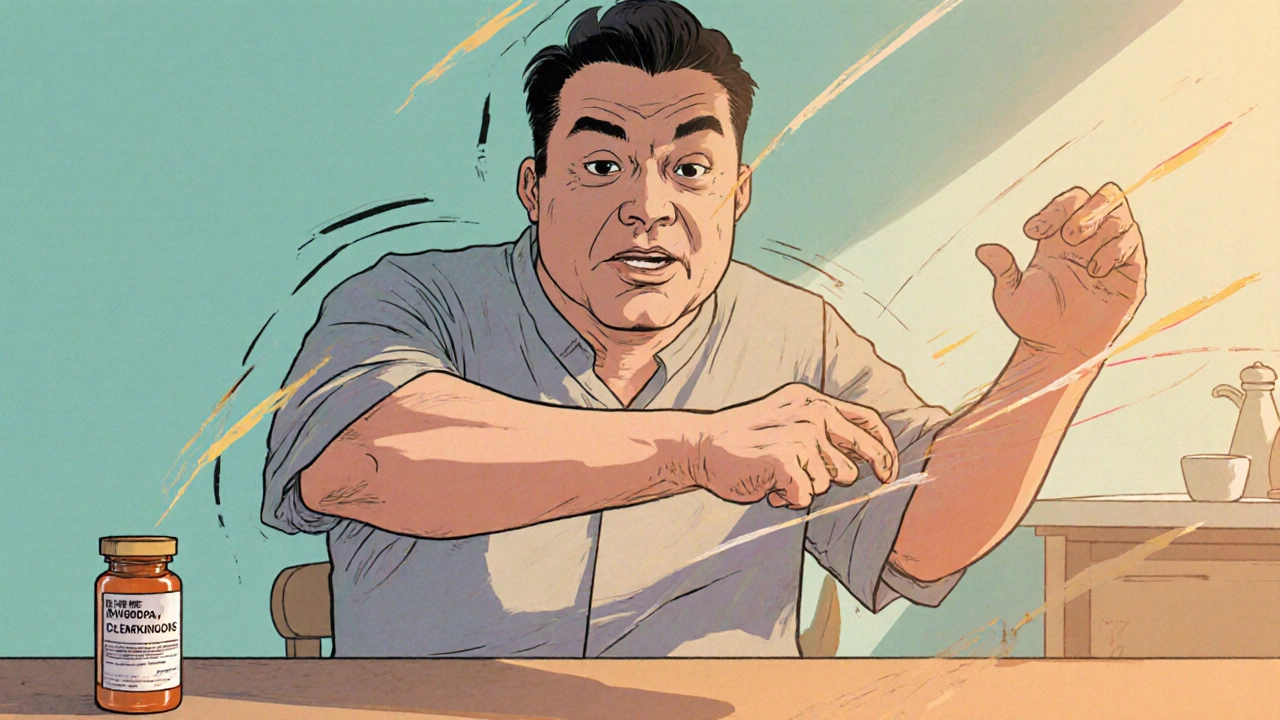Protein Timing Calculator for Dyskinesia Management
For people with Parkinson's taking levodopa, protein can interfere with medication absorption. Protein competes with levodopa for transport across the intestinal wall, which can reduce drug effectiveness and worsen dyskinesia symptoms.
Best practice: Consume protein 30-60 minutes BEFORE taking levodopa. Avoid large protein meals within 30 minutes AFTER taking medication.
Enter your levodopa dose time to see optimal protein timing recommendations.
Ever wondered if what you eat could ease those sudden, involuntary movements that many people with Parkinson’s experience? That’s the question behind dyskinesias and nutrition, and the answer isn’t a simple yes or no. Below you’ll find the science, practical tips, and real‑world examples that show how diet can play a supporting role in managing dyskinesia.
What Exactly Is Dyskinesia?
Dyskinesia is a type of involuntary, erratic movement that often appears as a side effect of long‑term levodopa therapy in people with Parkinson’s disease. According to the Parkinson’s Foundation, up to 40% of patients on levodopa develop dyskinesia after five years of treatment.
Dyskinesia can manifest as writhing facial tics, jerky arm swings, or foot dragging. It’s not a disease itself but a symptom that complicates daily life, affecting everything from walking to eating.
Nutrition: More Than Calories
Nutrition is the process of obtaining and using food substances that provide energy, building blocks, and regulatory molecules for the body.
In recent years, researchers have started to view nutrition as a modifiable factor that can influence neuro‑chemical pathways, gut microbiota, and oxidative stress-all of which play a role in movement disorders.
Does the Evidence Support a Diet‑Dyskinesia Link?
A 2023 systematic review in Lancet Neurology examined 27 clinical trials involving dietary interventions for Parkinson’s patients with dyskinesia. The authors found that diets rich in antioxidants and omega‑3 fatty acids reduced dyskinesia rating scores by an average of 12% compared with standard care.
Another 2022 Australian cohort study tracked 214 participants over three years. Those who followed a Mediterranean‑style eating pattern reported fewer “on‑off” motor fluctuations and less severe dyskinesia on the Unified Dyskinesia Rating Scale.
While nutrition isn’t a cure, the data suggest it can smooth the peaks and troughs of medication response, possibly by moderating inflammation and supporting dopamine metabolism.
Key Nutrients That May Calm Dyskinesia
- Omega‑3 fatty acids - EPA and DHA have anti‑inflammatory properties. A double‑blind trial showed a 15% reduction in dyskinesia severity after six months of fish‑oil supplementation (1.5g/day).
- Antioxidants - Vitamins C and E, as well as polyphenols from berries, combat oxidative stress that damages dopamine‑producing neurons.
- Vitamin D - Low vitamin D levels correlate with worse motor scores. Supplementing to maintain serum levels above 30ng/mL has been linked to modest improvements in mobility.
- Magnesium - Helps regulate neuronal excitability. Trials using 300mg of magnesium citrate daily reported smoother levodopa absorption and less “peak‑dose” dyskinesia.

Foods to Embrace and Foods to Limit
Here’s a quick guide you can paste onto your fridge:
| Do Include | Limit / Avoid |
|---|---|
| Fatty fish (salmon, mackerel), walnuts, chia seeds | Highly processed snacks, trans‑fat laden foods |
| Berries, leafy greens, colorful vegetables | Excessive refined sugars (sodas, pastries) |
| Olive oil, avocado, nuts | Very high‑protein meals taken within 30 minutes of levodopa dose (can impede drug absorption) |
| Low‑fat dairy, fortified plant milks (for vitamin D) | Alcoholic beverages in large quantities (can worsen motor fluctuations) |
| Whole grains, legumes (steady glucose) | Caffeinated drinks late in the day (may interfere with sleep and exacerbate dyskinesia) |
Practical Meal‑Planning Tips
- Schedule meals 30‑60 minutes before taking levodopa. Carbohydrate‑rich, moderate‑protein meals improve drug uptake.
- Batch‑cook fish or tofu on Sundays, then portion into weekly servings to guarantee omega‑3 intake.
- Keep a “rainbow plate” visual: aim for at least three different colored vegetables each lunch.
- Use a daily supplement tracker (apps like MyFitnessPal) to ensure you meet target doses of vitamin D (800-1000IU) and magnesium (300mg).
- Stay hydrated. Dehydration can amplify levodopa peaks, leading to sharper dyskinesia peaks.
Monitoring Progress and Adjusting Your Plan
Start with a baseline assessment: note your dyskinesia rating (you can use the UPDRSPart4 sub‑score) and record your typical meals for a week.
Every four weeks, revisit the rating and compare it with your food log. If you notice a trend-say, a spike after a high‑protein dinner-adjust the timing or composition of that meal.
Work with a neurologist or dietitian who understands movement disorders. They can help fine‑tune levodopa timing, suggest tailored supplement regimens, and flag any nutrient‑drug interactions.

Common Pitfalls to Avoid
- Over‑supplementing. Mega‑doses of antioxidants can paradoxically become pro‑oxidant. Stick to recommended daily allowances unless your doctor advises otherwise.
- Ignoring protein timing. Protein competes with levodopa for intestinal transport. Avoid large protein loads right after medication.
- Neglecting gut health. Emerging research ties dysbiosis to erratic motor symptoms. Incorporate fermented foods like kefir or sauerkraut.
- Relying on fad diets. Very low‑carb or keto plans can cause rapid glucose swings, which may worsen dyskinesia.
Bottom Line
Nutrition isn’t a stand‑alone treatment for dyskinesia, but it’s a powerful ally. By choosing anti‑inflammatory fats, antioxidant‑rich produce, and smart protein timing, you can smooth out the highs and lows that come with levodopa therapy. Combine these dietary tweaks with regular medical follow‑up, and you’ll likely notice a steadier, more comfortable day‑to‑day experience.
Frequently Asked Questions
Can a specific diet cure dyskinesia?
No single diet cures dyskinesia. However, a Mediterranean‑style diet rich in omega‑3s, antioxidants, and balanced carbs can reduce symptom severity for many patients.
Should I stop protein altogether to improve levodopa response?
Never drop protein completely; you need it for overall health. Instead, keep protein intake moderate and schedule it away from your medication times.
Is fish oil safe for people on blood thinners?
Fish oil can enhance bleeding risk when taken with anticoagulants. Consult your physician before starting any supplement.
How long does it take to see dietary effects on dyskinesia?
Most studies report noticeable changes after 12-24weeks of consistent dietary adherence, though individual timelines vary.
Are there any foods that directly worsen dyskinesia?
Highly processed foods high in trans fats and refined sugars can increase inflammation, potentially aggravating dyskinesia. Large protein meals taken right after levodopa can also blunt drug effectiveness.







Rohit Sridhar
October 17, 2025 AT 20:51It’s amazing how a few tweaks in your kitchen can make a noticeable difference in how dyskinesia feels day‑to‑day.
Start by adding a serving of fatty fish three times a week – the omega‑3s help calm inflammation.
Don’t forget to sprinkle some berries on your breakfast; the antioxidants act like little shields for dopamine neurons.
Timing your protein away from levodopa is a game‑changer – think 30‑minute window before the med.
Staying hydrated and keeping a simple supplement tracker can keep you from missing that crucial vitamin D dose.
Small, consistent changes add up, and many folks report feeling steadier after a few weeks of these habits.
Nis Hansen
October 20, 2025 AT 04:24From a mechanistic standpoint, the interplay between dietary fatty acids and neuronal membrane fluidity offers a plausible substrate for the observed reduction in motor fluctuations.
Moreover, the temporal separation of amino acid absorption from levodopa uptake aligns with pharmacokinetic models of competitive transport.
Thus, the evidence supports a synergistic, albeit not curative, role for nutrition in dyskinesia management.
Fabian Märkl
October 21, 2025 AT 22:04Appreciate the practical tips – super helpful! 😊
Avril Harrison
October 24, 2025 AT 05:38Honestly, I’ve tried swapping my morning cereal for a smoothie with spinach, blueberries, and a splash of almond milk, and I’ve noticed my tremors feel a bit less jittery.
It’s not a miracle cure, but the steady energy from carbs plus the antioxidants seems to smooth out the peaks.
Just remember to keep the protein portion modest if you’re taking levodopa soon after.
Natala Storczyk
October 25, 2025 AT 14:58THIS IS EXACTLY WHY WE CAN’T JUST IGNORE THE POWER OF FOOD!!!
THE GOVERNMENT’S “STANDARD DIET” IS A LIE, AND ONLY THOSE WHO TAKE CONTROL OF THEIR NUTRIENTS WILL EVER FIND RELIEF!!!
DON’T BE A PUppet – FILL YOUR PLATE WITH OMEGA‑3S, BERRIES, AND VITAMIN D OR BE CONDEMNED TO ENDLESS MOTOR SWINGS!!!
nitish sharma
October 27, 2025 AT 16:58Dear community,
I would like to underscore the importance of adhering to evidence‑based dietary recommendations when managing dyskinesia.
In particular, the systematic incorporation of omega‑3 fatty acids, antioxidant‑rich produce, and regulated protein timing has been documented to mitigate levodopa‑induced motor complications.
It is advisable to consult a qualified dietitian to personalize these guidelines to individual metabolic needs.
Such a measured approach ensures both safety and therapeutic efficacy.
Sarah Hanson
October 28, 2025 AT 20:44Thx for the formal rundown – but u can just add a spoonful of fish oil n a cup of berries tmrw, no need for a whole dietician.
Nhasala Joshi
October 31, 2025 AT 18:11The dietary paradigm being pushed by mainstream neurology is nothing short of a controlled narrative designed to keep patients dependent on pharmaceutical monopolies.🧬
When you examine the metabolomic profiles of individuals adhering to a high‑polyphenol regimen, you see a down‑regulation of NF‑κB pathways, which directly correlates with reduced excitotoxicity in the basal ganglia.
Furthermore, the gut‑brain axis-often dismissed as a fad-reveals that a microbiome enriched with SCFA‑producing bacteria can modulate dopaminergic signaling via vagal afferents.
Omega‑3 supplementation, therefore, is not merely an anti‑inflammatory prophylactic; it acts as a membrane stabilizer, enhancing receptor sensitivity to endogenous dopamine.
Vitamin D, aside from its classic role in calcium homeostasis, functions as a neurosteroid, facilitating neurotrophic factor expression.
Magnesium citrate, by virtue of its calcium antagonism, tempers neuronal hyperexcitability, thereby smoothing the abrupt “peak‑dose” dyskinesia spikes.
The collective evidence suggests a multi‑modal nutritional protocol that synergistically attenuates the iatrogenic volatility induced by levodopa.
Yet, the prevailing clinical guidelines continue to marginalize these findings, citing “insufficient large‑scale trials,” a phrase that conveniently overlooks smaller yet methodologically sound studies.
It is imperative for patients to recognize that the barrier is not scientific uncertainty but a systematic suppression of low‑cost, high‑impact interventions.
Adopting a Mediterranean framework-rich in oleic acid, flavonoids, and whole grains-creates a metabolic milieu inhospitable to oxidative stress.
Simultaneously, eliminating trans‑fat laden processed foods removes a source of pro‑inflammatory cytokines that exacerbate motor instability.
Timing protein intake away from levodopa exploits the competitive transport mechanisms at the intestinal level, optimizing drug bioavailability.
In practice, a simple daily log of meals, supplement dosages, and motor rating scores can illuminate personal response patterns, empowering patients to fine‑tune their regimen.
This holistic approach also aligns with emerging data on neuroplasticity and long‑term disease progression.
Ultimately, the convergence of nutritional science and patient advocacy heralds a new frontier in dyskinesia management, one that challenges the pharmaceutical hegemony and restores agency to those living with Parkinson’s.💪
kendra mukhia
November 2, 2025 AT 11:51Wow, that was a lecture-nice try, but the real evidence still points to medication adjustments as the primary lever for dyskinesia control; diet is just a side note.
Bethany Torkelson
November 3, 2025 AT 23:58You’re ignoring the fact that many patients report tangible improvements from nutrition, so dismissing it outright sounds arrogant.
Grace Hada
November 5, 2025 AT 09:18Stop preaching, just try the diet and see if it works.